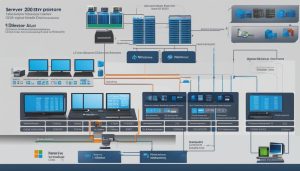Windows 3.1, released in 1992, was an operating system that marked a significant milestone in the evolution of personal computing. At the time of its release, PC usage in non-business settings was still uncommon, and the internet as we know it today was non-existent. Windows 3.1 was a program that required the underlying MS-DOS operating system to be present. While it had limitations such as no web browser and limited file management capabilities, it introduced features like drag and drop functionality and TrueType fonts that improved the user experience for tasks like music recording and word processing. Despite its limitations, Windows 3.1 was successful in driving the adoption of IBM-derivative PCs and holds nostalgic appeal for many users today.
Key Takeaways
- Windows 3.1 was a significant milestone in the evolution of personal computing.
- It required the underlying MS-DOS operating system to be present.
- Windows 3.1 introduced features like drag and drop functionality and TrueType fonts.
- Despite its limitations, Windows 3.1 played a crucial role in driving the adoption of IBM-derivative PCs.
- Windows 3.1 holds nostalgic appeal for many users today.
The Look and Feel of Windows 3.1
Windows 3.1 introduced an improved graphical user interface (GUI) that provided a more visually appealing experience compared to its predecessor, Windows 3.0. The UI featured colorful icons that took full advantage of the VGA and SVGA graphics standards, enhancing the overall aesthetics of the operating system. These icons added a touch of visual appeal, making the user interface more engaging and intuitive to navigate.
The introduction of TrueType fonts was another significant enhancement in Windows 3.1. These fonts greatly improved the readability of text on the screen, making the operating system a viable platform for desktop publishing and design. With TrueType fonts, users could enjoy a higher level of legibility and a more professional look for their documents and designs.
In addition to these visual improvements, Windows 3.1 also offered various themes for users to customize the look of their operating system. These themes, such as “Hotdog Stand” and “Power Saver Reverse,” allowed users to personalize their desktop environment and express their individuality in a fun and creative way.
Table: Windows 3.1 Themes
| Theme | Description |
|---|---|
| Hotdog Stand | A bright and colorful theme featuring vibrant hues of yellow, red, and green. Perfect for those who enjoy a fun and lively desktop environment. |
| Power Saver Reverse | A theme with a dark color scheme, primarily black and gray, designed to conserve energy and reduce eye strain. Ideal for users who prefer a more minimalist aesthetic. |
These themes allowed users to personalize their Windows 3.1 experience, making it feel more unique and tailored to their preferences. With its visually appealing icons, improved fonts, and customizable themes, Windows 3.1 provided a more enjoyable and personalized user interface.
Key Features of Windows 3.1
Windows 3.1 introduced several key features that significantly enhanced its functionality. Let’s take a closer look at some of these features:
1. Multitasking
One of the major advancements in Windows 3.1 was its improved multitasking capabilities. Users could now run multiple programs simultaneously, allowing for increased productivity and efficiency. With multitasking, you could have multiple applications running in the background while you worked on another task, making it easier to switch between different programs without the need to close and reopen them.
2. Memory Management
Windows 3.1 introduced enhanced memory management, allowing programs to utilize up to 256MB of RAM. This improvement increased the system’s ability to handle resource-intensive tasks, such as running complex applications or working with large files. Additionally, Windows 3.1 introduced virtual memory, which enabled the operating system to use disk space as additional memory when the physical memory was insufficient.
3. File Management
Windows 3.1 brought significant improvements to file management with the introduction of drag and drop functionality. This feature made it easier for users to manipulate files and organize their data. Instead of relying on commands or complex file operations, you could simply click and drag files to move or copy them to different locations within the file system.
4. Object Linking and Embedding (OLE)
Windows 3.1 introduced OLE, a technology that allowed for seamless integration of objects created in one application into documents created in another. With OLE, you could embed charts, spreadsheets, or other objects from one program into a document created in another program, enhancing collaboration and productivity.
These key features of Windows 3.1 greatly improved the user experience and laid the foundation for future advancements in operating systems. The multitasking capabilities, memory management enhancements, improved file management, and the introduction of OLE made Windows 3.1 a significant step forward in the evolution of personal computing.
Gaming and Entertainment on Windows 3.1
Windows 3.1 not only provided users with a functional operating system, but it also brought with it a range of gaming and entertainment options that kept users engaged and entertained. Two of the most iconic games included with Windows 3.1 were Solitaire and Minesweeper. Solitaire, a card game that has become synonymous with Windows, provided hours of gameplay and was a favorite pastime for many users. Minesweeper, a puzzle game where the player’s objective is to clear a minefield without detonating any mines, challenged players to think strategically and test their problem-solving skills.
In addition to these classic games, Windows 3.1 introduced a variety of screensavers to add visual interest to the user experience. Screensavers such as the classic flying Windows logo, Starfield, Mystify, and Swirl entertained users while their computers were idle. These screensavers not only added a touch of personalization to the operating system but also served as a form of relaxation and enjoyment for users.
Windows 3.1 also included a media player that allowed users to play multimedia content. Although hardware and installation challenges limited the widespread usage of multimedia features during that time, the media player provided users with the ability to enjoy audio and video content on their computers. This feature laid the foundation for the multimedia capabilities that would become an integral part of future Windows operating systems.
The Classic Windows 3.1 Solitaire Game
| Game | Description |
|---|---|
| Solitaire | A classic card game that became synonymous with Windows. The objective is to stack cards in descending order and alternate colors to ultimately move them to the foundation piles. |
| Minesweeper | A puzzle game where the player’s objective is to clear a minefield without detonating any mines. Players must strategically uncover squares and use numerical clues to determine the placement of mines. |
| Screensavers | Windows 3.1 introduced a variety of visually appealing screensavers, including the flying Windows logo, Starfield, Mystify, and Swirl. These screensavers provided users with a visually stimulating experience while their computers were idle. |
| Media Player | The media player included in Windows 3.1 allowed users to play multimedia content, laying the foundation for future multimedia capabilities in Windows operating systems. |
Architectural Improvements in Windows 3.1
Windows 3.1 brought significant architectural improvements to the operating system, enhancing its memory management, multi-tasking capabilities, and memory support. These advancements laid the groundwork for a more stable and efficient computing experience.
In terms of memory management, Windows 3.1 leveraged the protected mode of the CPU to allow for more efficient allocation and utilization of memory. This meant that Windows and Windows applications were able to access and use up to 256MB of RAM, providing users with increased performance and the ability to run more memory-intensive programs.
Another key improvement was in multi-tasking. Windows 3.1 introduced enhanced multi-tasking capabilities, allowing multiple DOS programs to run simultaneously. This meant that users could seamlessly switch between different applications, improving overall productivity and efficiency.
Furthermore, Windows 3.1 offered support for virtual memory, which allowed the operating system to extend beyond the physical memory limitations of the computer. This meant that even if the system had limited physical memory, Windows 3.1 could utilize virtual memory to provide additional space for running applications and managing data.
Table: Comparison of Windows 3.0 and Windows 3.1 Architectural Improvements
| Architectural Improvement | Windows 3.0 | Windows 3.1 |
|---|---|---|
| Memory Management | Limited memory utilization | Up to 256MB RAM support |
| Multi-tasking | Basic multi-tasking capabilities | Enhanced multi-tasking for simultaneous execution of multiple DOS programs |
| Virtual Memory | Not supported | Support for virtual memory beyond physical memory limits |
Overall, Windows 3.1 introduced architectural improvements that significantly enhanced the performance and functionality of the operating system. These advancements in memory management, multi-tasking, and memory support laid the foundation for future versions of the Windows operating system, contributing to the evolution of personal computing.
Limitations and Challenges of Windows 3.1
While Windows 3.1 introduced several advancements, it also had its fair share of limitations and challenges. One of the notable limitations was the restriction on file naming. Windows 3.1 only supported short filenames, which meant that both files and directories were limited to names with eight characters followed by a three-character suffix. This constraint often caused inconvenience and made it difficult to manage files effectively.
Another challenge with Windows 3.1 was hardware compatibility. Users often had to manually configure and install drivers for devices such as CD-ROM drives and sound cards. This process was often time-consuming and required technical expertise. Additionally, not all hardware was compatible with Windows 3.1, further limiting its usability.
Networking capabilities were also an area where Windows 3.1 faced challenges. Unlike modern operating systems that offer built-in networking support, Windows 3.1 relied on networking clients for MS-DOS. This meant that users had to install and configure separate networking software to enable network connectivity. It added complexity and made networking less user-friendly.
Despite these limitations and challenges, Windows 3.1 played a significant role in the evolution of personal computing. Its impact on subsequent versions of the Windows operating system is undeniable, and its legacy continues to be felt to this day. Windows 3.1 paved the way for the widespread adoption of PCs in non-business settings, and its nostalgic appeal remains strong among many users.
Conclusion
As I reflect on the impact and legacy of Windows 3.1, it’s clear that this operating system played a pivotal role in shaping the future of personal computing. Released in 1992, Windows 3.1 introduced significant improvements to the user interface, functionality, and architectural design that set the stage for subsequent versions of the Windows operating system.
With its vibrant icons, TrueType fonts, and customizable themes, Windows 3.1 elevated the visual experience for users and made desktop publishing and design more accessible. The introduction of multitasking, memory management enhancements, and drag and drop functionality improved productivity and efficiency.
Despite its limitations and challenges, such as the restriction to short filenames and hardware compatibility issues, Windows 3.1 paved the way for the widespread adoption of personal computers in non-business settings. Its impact is still felt today, and it holds a special place in the hearts of those who remember its introduction to the world of computing.
In conclusion, Windows 3.1 was not just a historic operating system but a stepping stone towards the modern computing landscape we know today. Its contributions and innovations laid the foundation for future advancements, making Windows 3.1 an important piece of technology history.
FAQ
What is Windows 3.1?
Windows 3.1 was an operating system released in 1992 that marked a significant milestone in personal computing. It introduced improved graphical user interface and functionality compared to its predecessor, Windows 3.0.
What were the key features of Windows 3.1?
Windows 3.1 introduced features such as multitasking, improved memory management, drag and drop functionality, and Object Linking and Embedding (OLE).
Did Windows 3.1 have gaming and entertainment options?
Yes, Windows 3.1 included games like Solitaire and Minesweeper, as well as screensavers and a media player.
What were the limitations of Windows 3.1?
Windows 3.1 had limitations such as short filenames, hardware compatibility issues, and limited networking capabilities.
How did Windows 3.1 impact personal computing?
Windows 3.1 played a vital role in shaping the future of personal computing by improving the user experience and paving the way for subsequent versions of the Windows operating system.
Janina is a senior specialist in information technology


